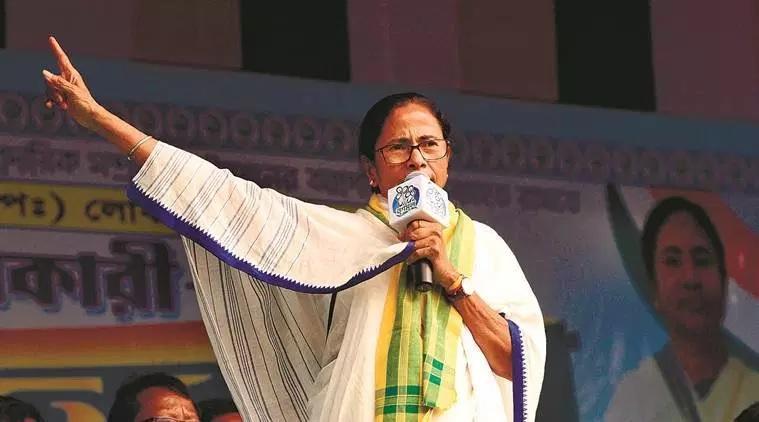Jai Shri Ram vs Jai Maa Kali Only Makes TMC the B-Team of Hindutva, Not a BJP Rival

Representational image. | Image Courtesy: The New Indian Express
When the Lok Sabha met after the 2019 elections, members of Parliament (MPs) from the Bharatiya Janata Party (BJP) created a ruckus with chants of Jai Shri Ram, Bharat Mata Ki Jai, and other openly religious or religion-flavoured slogans.
In response, several Opposition MPs, especially from West Bengal, chanted Jai Maa Kali and Jai Jagannath. Perhaps, they were under the impression that by asserting their religious identities, they were taking on the BJP’s homogenising slogans. Yet, they were walking into a trap set by the BJP and its parent body, the Rashtriya Swayamsevak Sangh (RSS).
The strategy of the RSS/BJP is to blend religion and politics. While some Opposition leaders did chant Inquilab Zindabad and Jai Bhim—slogans devoid of any religious connotation—these had few takers and were drowned out by the din of Jai Shri Ram.
Competitive Communalism: The Trinamool Way
A closer look shows that it is the BJP and the Trinamool Congress (TMC) who participated most actively in the competitive sloganeering in Parliament. It is obviously no coincidence that these two political outfits are also engaged in competitive communalism in West Bengal. The TMC has deployed a communal rhetoric in response to the BJP making inroads into West Bengal but the fact remains that this is a turf that only the former can claim as its own.
While the TMC has done next to nothing to improve the material conditions of the Muslim populace in West Bengal, the BJP has successfully portrayed the party and its government as “pro-Muslim”.
The strategies of both these parties started unfolding early on. First came the promise from the West Bengal government that it would give an allowance to imams and muezzins. This immediately became national news in which the TMC government was criticised for appeasing a particular religion. What didn’t catch the mass media’s eye was the cessation of recruitment of teachers for madrasas in West Bengal.
Again, for the first time, the idol immersion procession at the end of the Hindu festival of Durga Puja was postponed by the West Bengal administration. This was done on the pretext that its date was clashing with Muharram, which marks the beginning of a holy month for Muslims.
What was ignored is that the dates of these two religious events coincide every year and both have been traditionally conducted without any incident of disharmony. By stopping one for the other, TMC supremo Mamata Banerjee successfully played into the RSS’ narrative of so-called Muslim appeasement. She further catalysed this narrative by making persistent visits to religious places and creating a spectacle with her attempts to appropriate and encash minority religious sentiments.
This is why the TMC has regularly invited the charge that the BJP has grown in prominence in West Bengal due to active support from it. The party which has strangled other political forces in the state has readily conceded space to RSS. How else could the RSS establish more than 1,700 shakhas, or units, in the state in a short period of time?
The TMC fell into the trap of the RSS’s exclusive brand of polarising politics the moment it began competing with BJP in a field where the latter had been active even before its birth as a political party. Ground-level TMC workers started taking out Ram Navami processions, TMC legislators and ministers erected public statues of divinities from the Brahmanical pantheon such as Hanuman. The party supremo vehemently asserted her identity as a devout Hindu Brahmin at her rallies.
This is how Mamata Banerjee has allowed the RSS-BJP Hindutva agenda to emerge as a potent political force that is capable of influencing not just the minds of its potential supporters but also of shaping the counter-narrative and strategy of its political opponent. All this was done in a state with a distant history of communal violence (it would be a distortion of history to deny that Bengal in the turbulent 1940s was a hotbed of communal politics) which lay dormant under other popular aspirations.
It is evident that even after the 2019 elections, the TMC has refused to learn from its mistakes. It has continued with futile attempts to beat the BJP at its own game of fusing religion and politics. This Banerjee has done by instituting an alliance for Brahmin priests and publicly declaring that the Muslim community in Bengal as its “milch cow”.
The verbal skirmishes in the Lok Sabha were, therefore, merely a continuation of TMC and BJP’s competitive communalism, a battle that is strengthening the BJP in the state at the cost of all other political forces, including the TMC.
‘Bahujan’ leader Mamata Banerjee
A section of the popular press has projected Banerjee as one of the strongest opponents of Prime Minister Narendra Modi and his party, the BJP. Some in the academia have gone so far as to call her a “Bahujan leader” who has challenged “bhadralok” or genteel culture in Bengal.
The argument made in Mamata’s favour is that she has played a role in emancipation of Muslims. This is important considering the backdrop of the rise of Hindutva politics and its programmatic hate towards the community. However, the number of communal incidents in
West Bengal was almost nil until 2011—there was no major communal riot for the 34-year Left Front regime. This number spiked in 2014 and continued to rise until 2017.
One may argue that BJP’s ascendency at the national level since 2014 led to communal clashes in West Bengal. However, the obvious question is why Mamata Banerjee, as Chief Minister, could not stop them from happening.
The BJP had no political influence in West Bengal during the term of Prime Minister Atal Bihari Vajpayee. During the 1992 Babri mosque demolition and its violent aftermath and the 2002 Godhra incident and the Gujarat riots, West Bengal saw no instance of organised attacks against Muslims. The then Left Front government, along with the Left-led mass organisations in West Bengal, resisted the communal bloodbath that occurred elsewhere in the country.
West Bengal has a large section of Bangla and Urdu-speaking Muslims (second in percentage only to Uttar Pradesh), Bangla-speaking non-Muslims (Hindus, Buddhists, and the mostly Namashudra refugees who had migrated from Bangladesh in the wake of the Partition, precisely because of their religious identity). One of the biggest achievements of the Left in West Bengal was the successful translation of the livelihood issues of all these groups, irrespective of their diverse identities, into their political association.
However, within two years of TMC assuming power, the first communally-motivated violence was reported from Canning and since then, it has never stopped. Not just communal clashes. Consider the celebrated madrasa system of West Bengal. The West Bengal Madrasa Service Commission, which was established in 2008 by the Left Front government, had recruited 8,573 teaching and 1,165 non-teaching staff in 614 madrasas.
Before coming to power, Mamata Banerjee promised to provide affiliation to 10,000 madrasas. The number stands at 237 today. Between 2014 and 2019, not a single recruitment was made. Students who have cleared the exam are in a limbo. The West Bengal model of madrasa teaching was regarded as one of the most modernised and secular forms of teaching, where non-Muslim students accounted for 10 per cent students on average.
Today, that system faces a massive crisis due to the government’s utter negligence. If public-funded madrasas are closed, members of the marginalised sections, the poor and dalit-Muslims, will suffer the most. If Banerjee was serious about standing by Muslims as a community instead of appeasing its clerical orthodoxy, she should have made efforts for employment of the educated marginalised youth.
The fact is that the RSS’s project is not only political but is also knitted cleverly with religion and culture. Someone opposing Hindutva needs to be equipped with a stronger counter narrative. The question is, what counter-culture has Banerjee, the ‘Bahujan leader’ provided?
Unlike Mayawati, a dalit woman who tried to offer an alternative narrative around the dignity of her community—which is in complete opposition to brahminism and Hindutva—Banerjee has danced to RSS’s tune and has used Hinduised, brahminised utterances (such as Joy Ma Durga, Joy Ma Kali and so on) in her political articulations. There were ample avenues for her to celebrate non-brahminised local deities (for example, Shitala, Manasa, and Bonobibi) as a counter to brahamanvad. Instead, she gave state patronage to the bhadralok Hindu culture. She announced huge spending from government coffers for Durga Puja celebrations. This is where her anti-RSS project faltered.
Nowhere did Mamata Banerjee bring in the caste discourse in her political articulations. The question of representation for other identities in the TMC is also moot: Except Nirmal Majhi and three Muslim leaders, the party’s Executive Committee consists largely of elite and upper caste members.
Recently, the student organisation affiliated to TMC was accused of harassing and using racist slurs against an adivasi professor from Rabindra Bharati University, Kolkata. Last year, during the panchayat elections, two dalit agricultural labourers were burnt alive in West Bengal and again the finger of blame was pointed at the TMC. During the 2019 Lok Sabha elections, Kamirul Shaikh, a CPI(M) polling agent, was hacked to death, allegedly by TMC goons.
Note the contrasting note struck by Pinarayi Vijayan, the Chief Minister of Kerala. Though reviled by many liberals and supporters of Mamata Banerjee, the Ezhava backward caste leader has not only been resisting RSS politically and organisationally but, most importantly, also theoretically and ideologically. Or, consider the Devaswom Board, which has started recruiting non-brahmins as temple priests—a step inherently destructive to the traditional caste order, which is based on the notion that occupational choices and rights are birth-based.
Conversely, Mamata Banerjee’s struggles have the veneer of subjectivitiy. This is why her interventions invite the critique of being all about retaining power than offering a route to collective resistance. This is why, fundamenatlly, her attempts to challenge the RSS-BJP’s Hindutva offensive appears wishy-washy. When Jai Shri Ram is replaced by another set of competing religious slogans, the supposed act of opposition of Hindutva itself becomes a part and parcel of the Hindutva game plan.
The events during the oath-taking ceremony in the Lok Sabha only point to the limitations and vacuousness of the Opposition, in particular the TMC.
The writer is a student in St. Stephens College, New Delhi. Dipsita Dhar is a student activist. The views are personal.
Get the latest reports & analysis with people's perspective on Protests, movements & deep analytical videos, discussions of the current affairs in your Telegram app. Subscribe to NewsClick's Telegram channel & get Real-Time updates on stories, as they get published on our website.
























